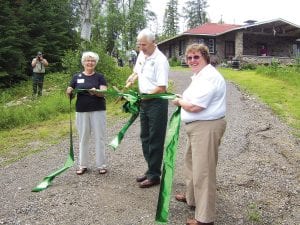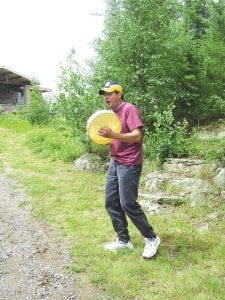Some of the descendants of Ed Nunstedt, who built Chik-Wauk Lodge in the 1930s – twice. After a dog kicked over a lantern and the first lodge building burned down before a single guest could stay there, Nunstedt built a stone building out of materials from the property. The lodge was in the hands of the Nunstedt family for about 20 years. L-R: Jenna Stoneback, Norb Mayer, Elizabeth Plapp, Martha Plapp, Carol Backlund, Carl Nunstedt (Ed and Ida’s son), Nancy Bargen, and Dave Bargen.

From conflict to collaboration. From natural disaster to community triumph. That is the story of the Gunflint Trail, the U.S. Forest Service, and the people who have loved this wild northern route to eastern Minnesota’s Canadian border lakes. About 350 people gathered on July 4, 2010 to celebrate the history of the Gunflint Trail at the grand opening of the Chik-Wauk Museum and Nature Center, the first major project of the Gunflint Trail Historical Society.
President Susan Kerfoot wrote in her 2010 annual review, “When Betty Hemstad accepted the presidency of the historical society, it was a society in name only. We had few members, no artifacts, no pictures, no museum and no future plans. There was a somewhat vague plan to build a museum at the old main lodge building on the former grounds of Chik- Wauk Lodge on Saganaga Lake.
“During her term as president Betty directed the society as it became a nonprofit corporation, secured a lease from the U.S. Forest Service on the property, became listed on the National Registry of Historic Places, hired a museum design company, secured financing, approved a museum plan, and set in motion the events that have led to this museum.

Above: Participating in the ribbon-cutting ceremony at the grand opening of the Chik-Wauk Museum and Nature Center July 4, 2010 were (L-R) museum committee chair and former president Betty Hemstad, Superior National Forest Gunflint District Ranger Dennis Neitzke, and committee historian and current president Susan Kerfoot. Left: Patrick Pierre,member of the Grand Portage Traditional Drum, participated in the ceremonies.
“Betty will be the first to admit that she didn’t do it alone. … Our first donations came from people who took a leap of faith that we could do what we said. TheU.S. Forest Service also had faith in us and supported our plans.”
So far, $938,000 has been raised in addition to a $250,000 endowment, and the society is 500 members strong.
“The Superior National Forest was born in controversy over 100 years ago,” Gunflint District Ranger Dennis Neitzke said at the opening ceremony. Part of the Boundary Waters was precluded from settlement in 1902, and “thus began the tension between those trying to utilize our area and those trying to preserve it from human development.”
The goals of the first Superior National Forest supervisor, Joe Fitzwater, were to restore trees to areas that had been logged off or burned over and to get people up here to use the land. Neitzke said that since Jim Sanders became the forest supervisor in 1996, he has worked hard to collaborate with people whose lives are directly affected by what happens on the Gunflint Trail, to restore the local economy, infrastructure, and forest, and to accomplish more through the development of partnerships.
“I believe together you have established a new community paradigm that is and will be coveted by many for years to come,” Sanders said. He recounted the history of the area, from prehistoric times to fur trading days, from the mining and logging era to the growth of the resort industry and the families who built it. Through fires and blowdowns, people continue to build community at places like Chik-Wauk.
“Today is about this unique and beautiful lodge and its surroundings,” Sanders said, “but even more, it symbolizes all that have been here before us, those here today, and those of future generations that now have the opportunity to stand here and understand the ‘community’ that I have come to know as the Gunflint Trail.”



Loading Comments